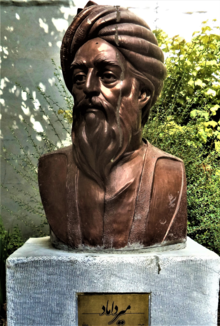Mir Damad

Mir Damad (
Philosophy
His major contribution to
Mir Damad’s many treatises on Islamic philosophy include Taqwim al-Iman (Calendars of Faith, a treasure on creation and divine knowledge), the Kitab Qabasat al-Ilahiyah (Book of the Divine Embers of Fiery Kindling), wherein he lays out his concept of atemporal origination, Kitab al-Jadhawat and Sirat al-Mustaqim. He also wrote poetry under the pseudonym of Ishraq (Illumination). He also wrote a couple of books on mathematics, but with secondary importance.
Among his many other students besides Mulla Sadra were Seyyed Ahmad-ibn-Reyn-al-A’bedin Alavi, Mohammad ibn Alireza ibn Agajanii, Qutb-al-Din Mohammad Ashkevari and Mulla Shams Gilani.
Mir Damad's philosophical prose is often accounted as being among the most dense and obtusely difficult of styles to understand, deliberately employing as well as coining convoluted philosophical terminology and neologisms that require systematic analysis and detailed commentary. He was called Mir Damad (Groom of the King) because he married
Architecture
Mir Damad was also the architect of the Masjide Shah (Shah Mosque) in Isfahan which employed highly advanced mathematical calculations which required the knowledge of the speed of sound at that time. The geometry of the dome is as such that all sound dissipated from the base will echo in hundreds of carefully calculated and masterly executed interior corners of the dome which will ultimately collide in the center of the dome. The geometrical analysis of the dome is of absolute sophistication and the design of the dome is a magnificent piece of art and furthermore the construction of such dome in the 17th century to a precision where all sound waves must travel and collide in an imaginary point above.
Family
His son was Seyed Ali Naghi Astarabadi and his grandson was Sayyid Mahdi bin Sayyid Ali Naqi. His daughter was the wife of Sayyid Ahmad ibn Zayn al-Abidin Alavi.
This article may be confusing or unclear to readers. (July 2022) |
The man has not been seen: Seyyed Ali Naqi Ibn Al-Seyyed Al-Musa (father of three sons: Seyyed Kamal Hassanzadeh Hafshjani, Seyyed Musa Hassanzadeh Hafshjani, Seyyed Mohammad Hafshjani and three daughters: Seyyed Ala Ala Begum Hassanzadeh Esther Shamsabadi, who had a special reputation): Mirza Nasrollah Karimian, Mirza Assadollah Karimian, Mirza Ali Karimian, Mirza Mehdi Karimian (father of musician Kaveh Karimian), Mirza Reza Karimian, Mirza Jalal Karimian, Mirza Hassan (father of Dr. Milad Karimian), Mirza Taghi Karimian, Seyedeh Tajzadeh Astarabad, Seyedeh Aghabazadeh, Hassanzadeh family).
Male result: Sayyid Hassan bin Al-Sayyid Mahdi
Works
Among his 134[1] works known:
- Taqwim al-Iman (Calendars of Faith)
- Kitab Qabasat al-Ilahiyah (Book of the Divine Embers of Fiery Kindling)
- Kitab al-Jadhawat (Book of Spiritual Attractions)
- Sirat al-Mustaqim (The Straight Path)
See also
- Islamic scholars
- List of Iranian scholars
- Sayyid Husayn Ahlati
References
- Islamic Philosophy from Its Origin to the Present: Philosophy in the Land of Prophecy, State University of New York Press, p. 214: "Some 134 works of Mir Damad have been identified ..."
Further reading
- Ian Richard Netton (2013). Encyclopedia of Islamic Civilization and Religion. Routledge, Oxon, UK. ISBN 1135179670.
- Encyclopædia Iranica: Mir Damad.
- Webster Encyclopedia of Religion.
- Rizvi, Sajjad H. (2006). "Between Time and Eternity: Mīr Dāmād on God's Creative Agency". Journal of Islamic Studies. 17 (2). Oxford University Press: 158–176. .
